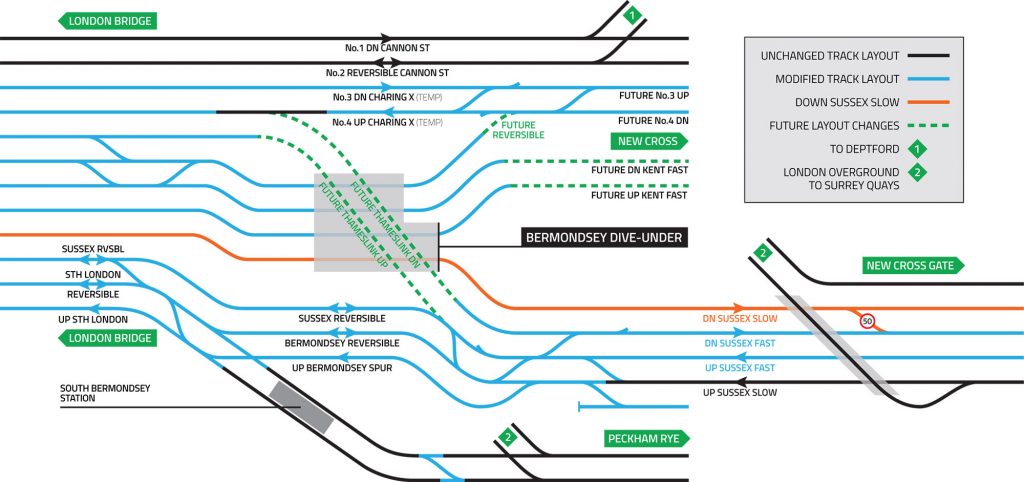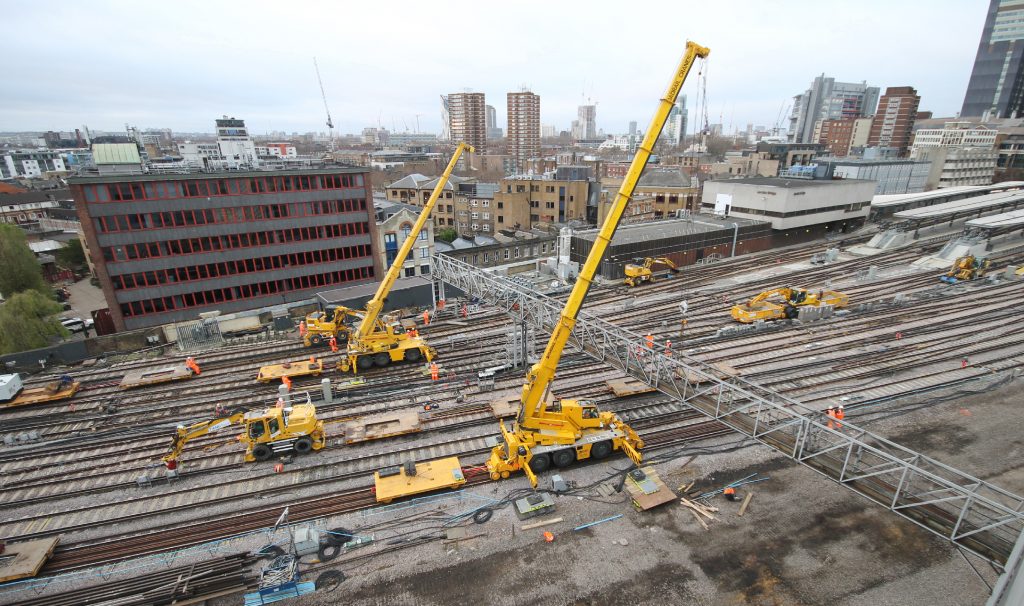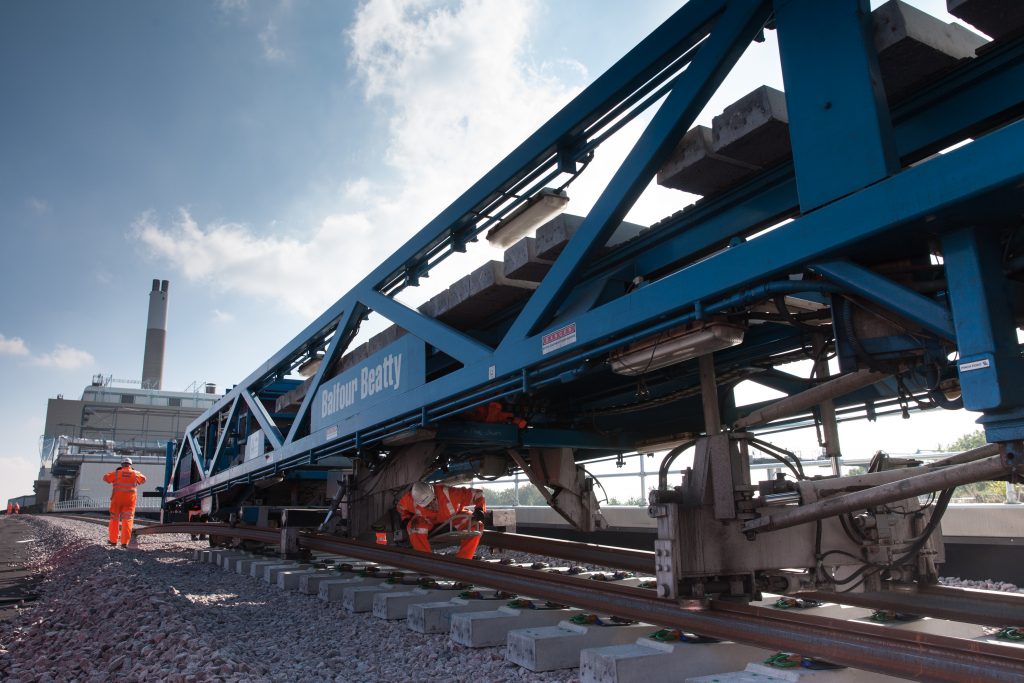The massive job of sorting out the approach tracks to London Bridge as part of the Thameslink project took a massive leap forward over the 2016 Christmas and New Year period. Back in the same period two years ago, the lines from New Cross Gate to the site of the old Spa Road station were reduced from four to three, with all trains to and from the Croydon/Sussex direction having to use the higher-level route adjacent to South Bermondsey station. This was to enable the demolition of the viaduct carrying the Up and Down Fast lines and the Down Slow.
The train service pattern was adjusted accordingly, but the planners did not get it quite right. For a number of different reasons, including drivers taking time to learn the new layout, station management issues and positioning of customer information screens at the station, significant disruption was experienced for a while, causing near-riot conditions at London Bridge station. As each of these issues was resolved, and by removing some trains from the timetable, the train service pattern settled down in the intervening period and reasonable reliability has resulted.
Christmas plan
The civil work to build the Bermondsey Dive Under was described in issue 142 (August 2016) and this will have the ultimate objective of allowing Southern, Thameslink and Southeastern train services to have dedicated routes into and through London Bridge, including the ongoing lines to Charing Cross, Blackfriars and Cannon Street. As an intermediate stage, however, getting an additional track into use for Croydon-bound services via New Cross Gate is an important step forward and will permit much needed flexibility for the operating authorities.
The total work packages over the period included:
- Bringing into use the Down ‘Sussex’ Slow line through the Bermondsey dive-under;
- Removal of two major signal gantries at London Bridge and Spa Road;
- Preparation for new power supplies as part of the improved resilience of power feeds to both the traction and signalling equipment in the wider London Bridge area;
- Renewal of 500 metres of plain line track on the Up Cannon Street track;
- Provision of eight new point ends at New Cross known as the Edward Street ladder.
Rail Engineer went to meet Mark Somers, the project director forsignalling and track, to learn how it all progressed.
Bermondsey dive-under
The construction of the grade separation dive-under was completed in October so that work to lay track and the provision of signalling could then commence. The Down Slow (known as Line 9) was provided with ballast using road vehicles, the track then being laid using the Balfour Beatty NTC (New Track Construction) train during a single day in November. This clever machine is constantly loaded with sleepers from coupled ‘Salmon’ wagons, dropping them off automatically at the right spacing as it moves forward. Rail is drawn off from further trailing wagons and positioned on to the sleepers, all in a single process.
Alignment and tamping followed after which the Down Slow line was used as an engineer’s line for ballasting and laying of track on adjacent lines.
At the southern end of the new line, a 50mph crossover was installed to provide a connection to the Down Fast line, removing the need for Down trains to be routed via the high level route adjacent to South Bermondsey.
The new line extends from Spa Road to New Cross Gate and is the first to use the dive-under.
Signalling the new line was relatively simple as the London Bridge central side had been controlled from Three Bridges ROC since January 2015.
It merely required the addition of five signals and two point ends to be commissioned onto the South Central work station.
New signalling on Line 9 was commissioned during Christmas Day and Boxing Day, with test trains running in the early hours of 27 December, and was made fully operational later that morning. On that same day, Line 8 from Spa Road to London Bridge has been secured out of use with Down direction signals fixed at red as, in a later stage, this will become the Up Kent Fast line into Platform 9 at the station.
References to Up and Down in the London Bridge area is slightly misleading, as most tracks will be signalled for reversible working and, indeed, Line 8 will still eventually be accessible from the terminal platforms should the need arise.
Most Down trains now use the new line to New Cross Gate, thus freeing up the higher-level route for Up trains and easing the potential for conflicting moves in the Bricklayers Arms junction area.
Signal gantry removal
Under the 1975 London Bridge re-signalling scheme, massive gantries were installed on the approach tracks spanning both the Central and SE lines. Two of these later became redundant, but removing them required a full possession of all lines.
The Christmas blockade was thus a heaven-sent opportunity.
One gantry near London Bridge station spanned 11 tracks, the other at Spa Road spanned nine. Both had one intermediate support. Rail mounted cranes were employed at both sites and, once the jib cables were connected, the booms were cut and lowered to ground level. These were then cut into sections and removed on rail-mounted plant.
Power supply enhancement
Four new power supply points have been deemed necessary to support the signalling requirements for the enhanced London Bridge area. Three
of these had been provided earlier but the fourth, at Lewisham, was commissioned over Christmas and forms part of the radial supply for the whole area. This will feed the signalling equipment rooms (REBs) at St Johns and Bermondsey.
In readiness for the provision of a new traction sub station at London Bridge, due to be brought into use in April, the power cables and routes needed for this were run in plus the abolition of TP huts (Track Paralleling) associated with the new Platforms 9, 10 and 11 on the south-east side.
Cannon Street line track renewal
The rebuilding of the platforms for Cannon Street services at London Bridge has involved slewing the associated two tracks over to where the Thameslink services will eventually be routed. However, the importance of the city terminus has meant that a service must be maintained, not stopping at London Bridge but necessitating keeping the approach tracks in good order.
Around 500 metres of plain line on Line 2 in the Spa Road area needed replacing, and what should have been a simple job turned out to have unexpected complications. The track sits on five weight-restricted bridges with the deck plates dating back to the 1900s. Renewal of the bridges will eventually have to happen but not at the current time. The use of modern track-laying machinery was ruled out for fear of damaging the deck plates so the new track was installed by traditional means – somewhat labour intensive but a safe option which took advantage of the time available over the New Year shutdown period.
Edward Street ladder junction
The Bermondsey grade separation affects the south-eastern side of London Bridge as well the Sussex lines, since trains for Charing Cross need to be re-routed to the western side of the future Thameslink tracks. The track layout in the New Cross area had to be prepared for this change, part of which was the renewal of eight point ends at Edward Street junction, just to the east of New Cross station. This will enable trains for Charing Cross and Cannon Street to be routed accordingly, and at higher speeds than at present.
In addition, the point machines have been upgraded from the HW1000-type to the more powerful HW2000 model. This involved changing from three to four wire operation, all part of making the signalling more resilient, seen as critical in the quest for greater reliability.
Signalling and telecommunications
Mention has been made of the additional signals, these being provided by Siemens as part of the Three Bridges ROC programme. The signalling is based around the Westlock solid- state interlocking, a well-proven product and capable of supporting ETCS when and if the lines are converted to ERTMS operation.
Track circuits of the Bombardier EBI Track 400- type are the chosen train detection technology, in preference to axle counters that are considered too risky at the present time for such a critical piece of railway. Although the EBI Track product had suffered from reliability problems in 2014, this has now been resolved. The FDM (frequency-division multiplexing) transmission links connecting outlying relay rooms to the old London Bridge power box have been replaced with TDM (time-division multiplexing) equipment.
It is the intention to use ‘Proceed on Signal Aspect’ conditions on the Thameslink route in future to minimise the effect of any point failures, allowing a driver to pass a red signal under controlled conditions. Another new feature, known as ‘Electronic Point Route Locking Release’, will also be a valuable addition to operational reliability and flexibility for the signaller when infrastructure failure conditions occur. Also planned are 170 Lock Out Devices (LOD) that effectively stop routes from being used when track patrols are taking place. These will give much needed safety assurance.
Whilst ARS (Automatic Route Setting) will be part of the final signalling methodology, this is not deployed currently as the constant changes to track layout and signals would mean frequently having to alter the ARS settings. ARS will be introduced, along with TMS (Traffic Management System) and ATO (Automatic Train Operation), for the Thameslink trains in late 2018.
The communication links back to Three Bridges are provided by NRT (Network Rail Telecoms) using its FTNx network. Because of the importance of these links, a virtual private network has been created, known as the TSPN (Thameslink Signalling Private Network), which provides four alternative paths back to the ROC and thus much greater resilience. The transmission uses Internet Protocols (IP), employing Cisco routers in line with modern-day practice. The GSM-R radio was checked for coverage through the dive-under lines and found not to need any enhancement.
Staffing and train operation
Around 250 engineers and technicians from both Network Rail and its contractors were on site during the Christmas and New Year period. The work was carefully planned and all went to schedule with only minor problems occurring with point detection equipment at New Cross. The work package cost £1.5 million, a sizeable amount but not unreasonable when considering what was achieved.
Balfour Beatty Rail Projects was contracted for all the track work and was supported by TXM, which provided associated plant. Road Rail Cranes were also contracted by Balfour Beatty and supplied AC40 and AC55 cranes. Siemens Rail Automation, as part of its overall contract for the ROC signalling, provided all the new signals, track circuits and point mechanisms needed for the revised track layout.
Train services revisions resulted in no Southern services running into London Bridge on Christmas Day and Boxing Day and no Southeastern services, other than on the Greenwich line, between Christmas Eve and 27 December whilst the Edward Street ladder junction was replaced. Trains were diverted to other terminals on the relevant days.
Ongoing work
This stage was, perhaps, to use Churchill’s words, “the end of the beginning”. 2017 will be a busy year for the London Bridge team with the following major work planned:
- Easter: Cannon Street lines slewed back to their new platforms at London Bridge with associated signalling, although the platforms will not re-open at this stage;
- Spring Bank Holiday: point work at Blackfriars leading down to London Bridge will be remodelled, including Southwark Bridge junction and new signals and track circuits;
- August Bank Holiday: a nine-day blockade to reconfigure the Charing Cross line platforms at London Bridge and bring Platform 6 into use. Also the Up and Down Fast approach lines from Kent will be routed through the dive-under with major track slewing at New Cross;
- Christmas: the final layout will be introduced including the new Thameslink tracks through London Bridge station and over the new flyover at Bermondsey.
To put it into perspective, the London Bridge project started in May 2013 with a 41⁄2 year programme involving the complete rebuilding of London Bridge station, over 100 track stages and 11 major commissionings, all costing £3.2 billion. So far, and despite what many passengers may think, it has all has gone to plan.
Thanks to Mark Somers and to Alexandra Swann, communications manager for Thameslink, for their explanations regarding these works.
Written by Clive Kessell





